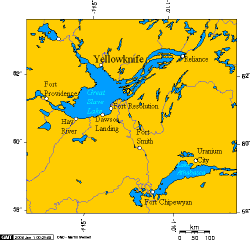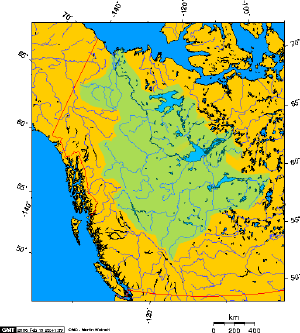Difference between revisions of "Great Slave Lake" - New World Encyclopedia
Mary Anglin (talk | contribs) (import credit and claim for Anglin) |
Vicki Phelps (talk | contribs) |
||
| Line 3: | Line 3: | ||
|lake_name = Great Slave Lake | |lake_name = Great Slave Lake | ||
|image_lake = Great Slave Lake and Lake Athabasca 6.png | |image_lake = Great Slave Lake and Lake Athabasca 6.png | ||
| − | |caption_lake = Great Slave Lake and | + | |caption_lake = Great Slave Lake and Lake Athabasca |
|image_bathymetry = | |image_bathymetry = | ||
|caption_bathymetry = | |caption_bathymetry = | ||
|coords = {{coor at dm|61|40|N|114|00|W|region:CA-NT_type:waterbody_scale:10000000}} | |coords = {{coor at dm|61|40|N|114|00|W|region:CA-NT_type:waterbody_scale:10000000}} | ||
| − | |type = remnant of a vast | + | |type = remnant of a vast glacial lake |
| − | |inflow = | + | |inflow = Hay River, Slave River |
| − | |outflow = | + | |outflow = Mackenzie River |
| − | |catchment = 985,300 km² <br> (380,600 sq mi) | + | |catchment = 985,300 km² <br/> (380,600 sq mi) |
| − | |basin_countries = | + | |basin_countries = Canada |
|length = 480 km (298 mi) | |length = 480 km (298 mi) | ||
|width = 109 km (68 mi) | |width = 109 km (68 mi) | ||
| − | |area = | + | |area = 28,400 km² (11,000 sq mi) |
|max-depth = 614 m (2,015 ft) | |max-depth = 614 m (2,015 ft) | ||
| − | |volume = 2,090 km³ (501.7 cu mi, 1.694 billion | + | |volume = 2,090 km³ (501.7 cu mi, 1.694 billion acre feet) |
|residence_time = | |residence_time = | ||
|shore = | |shore = | ||
| Line 23: | Line 23: | ||
|cities = | |cities = | ||
}} | }} | ||
| − | [[Image:Mackenzie River drainage basin.PNG|thumb| | + | [[Image:Mackenzie River drainage basin.PNG|thumb|Mackenzie River drainage basin showing Great Slave Lake's position in the Western Canadian Arctic]] |
| − | '''Great Slave Lake''' (French: ''Grand lac des Esclaves'') is the second-largest [[lake]] in the [[Northwest Territories]] of [[Canada]] (behind [[Great Bear Lake]]), the deepest lake in [[North America]] at 614 m (2,015 ft), and the | + | '''Great Slave Lake''' (French: ''Grand lac des Esclaves'') is the second-largest [[lake]] in the [[Northwest Territories]] of [[Canada]] (behind [[Great Bear Lake]]), the deepest lake in [[North America]] at 614 m (2,015 ft), and the ninth-largest lake in the world. It is 480 km (298 mi) long and 19 to 109 km (12 to 68 mi) wide. It covers an area of 28,400 km² (11,000 sq mi) in the southern part of the territory. Its volume is 2,090 km³ (501.7 cu mi,1.694 billion acre feet). The lake was named for the Slavey [[Indigenous peoples of the Americas|North American Indians]]. |
| − | The | + | The Hay and Slave Rivers are its chief tributaries. It is drained by the Mackenzie River. Though the western shore is forested, the east shore and northern arm are [[tundra]]-like. The southern and eastern shores reach the edge of the [[Canadian Shield]]. Along with other lakes such as the Great Bear and Athabasca, it is a remnant of a vast post-glacial lake. |
| − | The | + | The east arm of Great Slave Lake is filled with islands. The Pethei Peninsula separates the east arm into McLeod Bay in the north and Christie Bay in the south. The only community in the east arm is Lutselk'e, a hamlet of about 350 people, largely Chipewyan aboriginals of the Dene Nation. |
== History == | == History == | ||
| − | + | First Nations were the first settlers around the lake, building communities including Dettah, which still exists today. | |
| − | [[United Kingdom|British]] | + | [[United Kingdom|British]] fur trader Samuel Hearne explored the area in 1771 and crossed the frozen lake, which he initially named Lake Athapuscow (after an erroneous French speaker's pronunciation of Athabaska). |
| − | In the | + | In the 1930s, [[gold]] was discovered there, which led to the establishment of [[Yellowknife, Northwest Territories|Yellowknife]], the territory's capital. |
| − | In 1967, an all-season highway was built around the lake, originally an extension of the | + | In 1967, an all-season highway was built around the lake, originally an extension of the Mackenzie Highway but now known as Highway 3. |
| − | On | + | On January 24, 1978, a [[Soviet Union|Soviet]] Radar Ocean Reconnaissance Satellite, named Cosmos 954, built with an onboard [[nuclear reactor]] fell from orbit and landed in the lake. With all the ice and snow on the lake the satellite exploded on impact, causing its nuclear fuel to fall over the area. The nuclear fuel was picked up by a group called Operation Morning Light, formed with both [[United States|American]] and [[Canada|Canadian]] members.<ref>{{cite web|url=http://gsc.nrcan.gc.ca/gamma/ml_e.php|title=Operation Morning Light|author=Natural Resources Canada|authorlink=Natural Resources Canada|accessdate=2007-01-24}}</ref> |
== General Information == | == General Information == | ||
| − | Other towns around the lake include: | + | Other towns around the lake include: Yellowknife, Fort Providence, Hay River and Fort Resolution. |
| − | The lake is at least partially frozen during an average of | + | The lake is at least partially frozen during an average of eight months of the year. During winter, the ice is thick enough for semi-trailer trucks to pass over. Until 1967, when an all-season highway was built around the lake, goods were shipped across the ice to Yellowknife, located on the north shore. Goods and fuel are still shipped across frozen lakes up the winter road to the [[diamond]] [[mining|mines]] located near the headwaters of the Coppermine River, Northwest Territories. A ferry is required to access Yellowknife during spring when the ice is not present in a solid sheet along Highway 3 where it crosses the Mackenzie River. |
| − | South of Great Slave Lake, in a remote comer of | + | South of Great Slave Lake, in a remote comer of Wood Buffalo National Park, is the nesting site of a remnant flock of whooping [[crane]]s, discovered in 1954.<ref>{{cite web| url=http://digitalcommons.unl.edu/biosciornithology/19/ |author=University of Nebraska |authorlink=University of Nebraska| title=Whooper Recount| accessdate=2007-01-20}}</ref> |
| − | |||
| − | |||
| − | |||
| − | |||
| − | |||
== Notes == | == Notes == | ||
Revision as of 02:51, 13 December 2007
| Great Slave Lake | |
|---|---|
| Coordinates | |
| Lake type | remnant of a vast glacial lake |
| Primary sources | Hay River, Slave River |
| Primary outflows | Mackenzie River |
| Catchment area | 985,300 km² (380,600 sq mi) |
| Basin countries | Canada |
| Max length | 480 km (298 mi) |
| Max width | 109 km (68 mi) |
| Surface area | 28,400 km² (11,000 sq mi) |
| Max depth | 614 m (2,015 ft) |
| Water volume | 2,090 km³ (501.7 cu mi, 1.694 billion acre feet) |
| Surface elevation | 156 m (512 ft) |
Great Slave Lake (French: Grand lac des Esclaves) is the second-largest lake in the Northwest Territories of Canada (behind Great Bear Lake), the deepest lake in North America at 614 m (2,015 ft), and the ninth-largest lake in the world. It is 480 km (298 mi) long and 19 to 109 km (12 to 68 mi) wide. It covers an area of 28,400 km² (11,000 sq mi) in the southern part of the territory. Its volume is 2,090 km³ (501.7 cu mi,1.694 billion acre feet). The lake was named for the Slavey North American Indians.
The Hay and Slave Rivers are its chief tributaries. It is drained by the Mackenzie River. Though the western shore is forested, the east shore and northern arm are tundra-like. The southern and eastern shores reach the edge of the Canadian Shield. Along with other lakes such as the Great Bear and Athabasca, it is a remnant of a vast post-glacial lake.
The east arm of Great Slave Lake is filled with islands. The Pethei Peninsula separates the east arm into McLeod Bay in the north and Christie Bay in the south. The only community in the east arm is Lutselk'e, a hamlet of about 350 people, largely Chipewyan aboriginals of the Dene Nation.
History
First Nations were the first settlers around the lake, building communities including Dettah, which still exists today.
British fur trader Samuel Hearne explored the area in 1771 and crossed the frozen lake, which he initially named Lake Athapuscow (after an erroneous French speaker's pronunciation of Athabaska).
In the 1930s, gold was discovered there, which led to the establishment of Yellowknife, the territory's capital.
In 1967, an all-season highway was built around the lake, originally an extension of the Mackenzie Highway but now known as Highway 3.
On January 24, 1978, a Soviet Radar Ocean Reconnaissance Satellite, named Cosmos 954, built with an onboard nuclear reactor fell from orbit and landed in the lake. With all the ice and snow on the lake the satellite exploded on impact, causing its nuclear fuel to fall over the area. The nuclear fuel was picked up by a group called Operation Morning Light, formed with both American and Canadian members.[1]
General Information
Other towns around the lake include: Yellowknife, Fort Providence, Hay River and Fort Resolution.
The lake is at least partially frozen during an average of eight months of the year. During winter, the ice is thick enough for semi-trailer trucks to pass over. Until 1967, when an all-season highway was built around the lake, goods were shipped across the ice to Yellowknife, located on the north shore. Goods and fuel are still shipped across frozen lakes up the winter road to the diamond mines located near the headwaters of the Coppermine River, Northwest Territories. A ferry is required to access Yellowknife during spring when the ice is not present in a solid sheet along Highway 3 where it crosses the Mackenzie River.
South of Great Slave Lake, in a remote comer of Wood Buffalo National Park, is the nesting site of a remnant flock of whooping cranes, discovered in 1954.[2]
Notes
- ↑ Natural Resources Canada. Operation Morning Light. Retrieved 2007-01-24.
- ↑ University of Nebraska. Whooper Recount. Retrieved 2007-01-20.
Sources and further reading
Credits
New World Encyclopedia writers and editors rewrote and completed the Wikipedia article in accordance with New World Encyclopedia standards. This article abides by terms of the Creative Commons CC-by-sa 3.0 License (CC-by-sa), which may be used and disseminated with proper attribution. Credit is due under the terms of this license that can reference both the New World Encyclopedia contributors and the selfless volunteer contributors of the Wikimedia Foundation. To cite this article click here for a list of acceptable citing formats.The history of earlier contributions by wikipedians is accessible to researchers here:
The history of this article since it was imported to New World Encyclopedia:
Note: Some restrictions may apply to use of individual images which are separately licensed.

